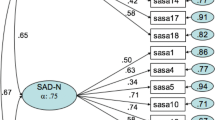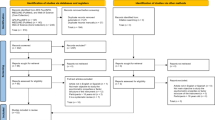Abstract
The Liebowitz Social Anxiety Scale for Children and Adolescents (LSAS-CA-SR) is a validated instrument for the assessment of social anxiety in youth. The three main objectives of the present study were to (a) examine the factor structure of the LSAS-CA-SR; (b) to validate the factors against relevant personality measures, and (c) to create a brief and reliable version of the questionnaire. A total of 1,362 adolescents completed self-report measures of social anxiety, temperament, character and personality traits. The factor structure was examined using a combination of confirmatory and exploratory factor analysis. The analysis was conducted on both the anxiety and avoidance sub-scales, and identical items for both sub-scales were maintained. Two factors emerged: social interaction and school performance. These factors demonstrated high internal consistency and a significant correlation with relevant self-report measures. A brief version comprised of 14 items was highly correlated (0.96) with the full version. The new factor structure represents advancement over the previous efforts, and holds promise for efficient utilization of the LSAS-CA.
Similar content being viewed by others
References
American Psychiatric Association (2000) Diagnostic and statistical manual of mental disorders DSM-IV-TR, 4th edn, text revision. American Psychiatric Publication, Washington, DC
Schneier FR, Johnson J, Hornig CD, Liebowitz MR, Wiesman MM (1992) Social phobia: comorbidity and morbidity in an epidemiologic sample. Arch Gen Psychiatry 49(4):282–288
Kessler RC, McGonagle KA, Zhao S, Nelson CB, Hughes M, Eshleman S, Wittchen HU, Kendler KS (1994) Lifetime and 12-month prevalence of DSM-III-R psychiatric disorders in the United States: results from the National Comorbidity Study. Arch Gen Psychiatry 51(1):8–19
Gren-Landell M, Tillfors M, Furmark T, Bohlin G, Andersson G, Svedin CG (2009) Social phobia in Swedish adolescents: prevalence and gender differences. Soc Psychiatry Psychiatr Epidemiol 44(1):1–7
Essau CA, Conradt J, Petermann F (1999) Frequency and comorbidity of social phobia and social fears in adolescents. Behav Res Ther 37(9):831–843
Starr LR, Davila J (2008) Differentiating interpersonal correlates of depressive symptoms and social anxiety in adolescence: implications for models of comorbidity. J Clin Child Adolesc Psychol 37(2):337–349
Kessler RC, Stang P, Wittchen H-U, Stein M, Walters EE (1999) Lifetime comorbidities between social phobia and mood disorders in the US National Comorbidity Survey. Psychol Med 29(3):555–567
Pine DS, Cohen P, Gurley D, Brook J, Ma Y (1998) The risk for early-adulthood anxiety and depressive disorders in adolescents with anxiety and depressive disorders. Arch Gen Psychiatry 55(1):56–64
Aderka IM, Hofmann SG, Nickerson A, Hermesh H, Gilboa-Schechtman E, Marom S (2012) Functional impairment in social anxiety disorder. J Anxiety Disord 26(3):393–400
Wittchen HU, Fuetsch M, Sonntag H, Müller N, Liebowitz M (1999) Disability and quality of life in pure and comorbid social phobia: findings from a controlled study. Eur Psychiatry 14(3):118–131
Liebowitz MR (1987) Social phobia. Mod Probl Pharmacopsychiatry 22:141–173
Baker SL, Heinrichs N, Kim H-J, Hofmann SG (2002) The Liebowitz Social Anxiety Scale as a self-report instrument: a preliminary psychometric analysis. Behav Res Ther 40(6):701–715
Mennin DS, Fresco DM, Heimberg RG, Schneier FR, Davies SO, Liebowitz MR (2002) Screening for social anxiety disorder in the clinical setting: using the Liebowitz Social Anxiety Scale. J Anxiety Disord 16(6):661–673
Fresco DM, Coles ME, Heimberg RG et al (2001) The Liebowitz Social Anxiety Scale: a comparison of the psychometric properties of self-report and clinician-administered formats. Psychol Med 31(6):1025–1035
Masia-Warner C, Storch EA, Pincus DB, Klein RG, Heimberg RG, Liebowitz MR (2003) The Liebowitz Social Anxiety Scale for Children and Adolescents: an initial psychometric investigation. J Am Acad Child Adolesc Psychiatry 42(9):1076–1084
Hofmann SG, Albano AM, Heimberg RG, Tracey S, Chorpita BF, Barlow DH (1999) Subtypes of social phobia in adolescents. Depression Anxiety 9(1):15–18
Albano AM (1995) Treatment of social anxiety in adolescents. Cogn Behav Pract 2(2):271–298
Beidel DC (1991) Social phobia and overanxious disorder in school-age children. J Am Acad Child Adolesc Psychiatry 30(4):545–552
Leary MR, Kowalski RM, Campbell CD (1988) Self-presentational concerns and social anxiety: the role of generalized impression expectancies. J Res Pers 22(3):308–321
Safren SA, Heimberg RG, Horner KJ, Juster HR, Schneier FR, Liebowitz MR (1999) Factor structure of social fears: the Liebowitz Social Anxiety Scale. J Anxiety Disord 13(3):253–270
Oakman J, Van Ameringen M, Mancini C, Farvolden P (2003) A confirmatory factor analysis of a self-report version of the Liebowitz Social Anxiety Scale. J Clin Psychol 59(1):149–161
Heimberg RG (2007) Examination of the known-groups validity of the Liebowitz Social Anxiety Scale. Depression Anxiety 24:447–454
Perugi G, Nassini S, Maremmani I, Madaro D, Toni C, Simonini E, Akiskal HS (2001) Putative clinical subtypes of social phobia: a factor-analytical study. Acta Psychiatr Scand 104(4):280–288
Beard C, Rodriguez BF, Moitra E, Sibrava NJ, Bjornsson A, Weisberg RB, Keller MB (2011) Psychometric properties of the Liebowitz Social Anxiety Scale (LSAS) in a longitudinal study of African Americans with anxiety disorders. J Anxiety Disord 25(5):722–726
Romm KL, Rossberg JI, Berg AO, Hansen CE, Andreassen OA, Melle I (2011) Assessment of social anxiety in first episode psychosis using the Liebowitz Social Anxiety scale as a self-report measure. Eur Psychiatry 26(2):115–121
Terra MB, Barros HMT, Stein AT, Figueira I, Athayde LD, Gonçalves MS, Tergolina LPR, Dartiu XJS (2006) Internal consistency and factor structure of the Portuguese version of the Liebowitz Social Anxiety Scale among alcoholic patients Consistência interna e estrutura fatorial da versão em português da Escala de Ansiedade Social de Liebowitz entre pacientes. Terra 28(4):265–269
Levin JB, Marom S, Gur S, Wechter D, Hermesh H (2002) Psychometric properties and three proposed subscales of a self-report version of the Liebowitz Social Anxiety Scale translated into Hebrew. Depression Anxiety 16(4):143–151
Storch EA, Masia-Warner C, Heidgerken AD, Fisher PH, Pincus DB, Liebowitz MR (2006) Factor structure of the Liebowitz Social Anxiety Scale for Children and Adolescents. Child Psychiatry Hum Dev 37(1):25–37
López-Pina JA, Olivares J, Sánchez-García R (2008) Rasch modeling of the Spanish self-report version of the Liebowitz Social Anxiety Scale for Children and Adolescents (LSAS-CA-SR). Int J Clin Health Psychol 8(1):233–245
Cox BJ, Ross L, Swinson RP, Direnfeld DM (1998) A comparison of social phobia outcome measures in cognitive-behavioral group therapy. Behav Modif 22(3):285–297
Carleton RN, McCreary DR, Norton PJ, Asmundson GJG (2006) Brief fear of negative evaluation scale—revised. Depression Anxiety 303:297–303
Garcia-Lopez LJ, Hidalgo MD, Beidel DC, Olivares J, Turner SM (2008) Brief form of the social phobia and anxiety inventory (SPAI-B) for adolescents. Eur J Psychol Assess 24(3):150–156
Krefetz D, Steer R (2004) Screening HIV-infected patients with chronic pain for anxiety and mood disorders with the Beck Anxiety and Depression Inventory-Fast Screens for Medical Settings. J Clin Psychol Med Settings 11(4):283–289
Luby JL, Svrakic DM, McCallum K, Przybeck TR, Cloninger CR (1999) The junior temperament and character inventory: preliminary validation of a child self-report measure. Psychol Rep 84(3, Pt 2):1127–1138
Barratt ES (1959) Anxiety and impulsiveness related to psychomotor efficiency. Percept Mot Skills 9(2):191–198
Stanford MS, Mathias CW, Dougherty DM, Lake SL, Anderson NE, Patton JH (2009) Fifty years of the Barratt Impulsiveness Scale: an update and review. Pers Individ Differ 47(5):385–395
Zuckerman M, Kolin EA, Price L, Zoob I (1964) Development of a sensation-SEEKING scale. J Consult Psychol 28(6):477–482
Zuckerman M (1971) Dimensions of sensation seeking. J Consult Clin Psychol 36(1):45–52
Leary MR (2001) Shyness and the self: attentional, motivational, and cognitive self-processes in social anxiety and inhibition. In: Crozier WR, Alden LE (eds) International handbook of social anxiety: concepts, research and interventions relating to the self and shyness. Wiley, New York, NY, pp 217–234
Cloninger CR (1998) The genetics and psychololgy of the seven factor model of personality. In: Silkm KS (ed) Biology of personality disorders. American Psychiatric Press, Washington, DC, pp 63–92
Asch M, Cortese S, Perez-Diaz F, Pelissolo A, Aubron V, Orejarena S, Acquaviva E, Mouren MC, Michel G, Gorwood P, Purper-Quakil D (2009) Psychometric properties of a French version of the junior temperament and character inventory. Eur Child Adolesc Psychiatry 18(3):144–153
Cho S-C, Jung S-W, Kim B-N, Hwang JW, Shin MS, Kim JW, Chungh DS, Kim HW (2009) Temperament and character among Korean children and adolescents with anxiety disorders. Eur Child Adolesc Psychiatry 18(1):60–64
Rettew DC, Copeland W, Stanger C, Hudziak JJ (2004) Associations between temperament and DSM-IV externalizing disorders in children and adolescents. J Dev Behav Pediatr 25(6):383–391
Sancho C, Arija MV, Canals J (2008) Personality in non-clinical adolescents with eating disorders. Eur Eat Disord Rev 16(2):133–138
Gothelf D, Aharonovsky O, Horesh N, Carty T, Apter A (2004) Life events and personality factors in children and adolescents with obsessive-compulsive disorder and other anxiety disorders. Compr Psychiatry 45(3):192–198
Patton JH, Stanford MS, Barratt ES (1995) Factor structure of the Barratt Impulsiveness Scale. J Clin Psychol 51(6):768–774
Leshem R, Glicksohn J (2007) The construct of impulsivity revisited. Pers Individ Differ 43(4):681–691
Roberti JW, Storch EA, Bravata E (2003) Further psychometric support for the Sensation Seeking Scale–Form V. J Pers Assess 81(3):291–292
Menucha B (1986) On the construct validity of the sensation seeking scale in a non-English-speaking culture. Pers Individ Differ 7(3):431–434
Su Y-J, Chen S-H (2008) The posttraumatic cognitions inventory-Chinese revised: validation and refinement with a traumatized college sample in Taiwan. J Anxiety Disord 22(7):1110–1119
Daie-Gabai A, Aderka IM, Allon-Schindel I, Foa EB, Gilboa-Schechtman E (2011) Posttraumatic Cognitions Inventory (PTCI): psychometric properties and gender differences in an Israeli sample. J Anxiety Disord 25(2):266–271
Ullman JB (2006) Structural equation modeling: reviewing the basics and moving forward. J Pers Assess 87(1):35–50
Kahn JH (2006) Factor analysis in counseling psychology research, training, and practice: principles, advances, and applications. Couns Psychol 34(5):684–718
Costello A, Osborne J (2011) Best practices in exploratory factor analysis: four recommendations for getting the most from your analysis. Pract Assess Res Eval 10(7):1–9
Cattell RB (ed) (1966) Handbook of multivariate experimental psychology. Rand McNally, Chicago
Horn JL (1965) A rationale and test for the number of factors in factor analysis. Psychometrika 30(2):179–185
Satorra A, Bentler PM (2001) A scaled difference Chi square test statistic for moment structure analysis. Psychometrika 66(4):507–514
Bentler PM (1990) Comparative fit indexes in structural models. Psychol Bull 107(2):238–246
Bollen KA (1989) Structural equations with latent variables. Wiley, Oxford, xiv, 514
Bentler P, Bonett D (1980) Significance tests and goodness of fit in the analysis of covariance structures. Psychol Bull 88(3):588–606
Steiger JH (1980) Tests for comparing elements of a correlation matrix. Psychol Bull 87(2):245–251
Hu L, Bentler PM (1999) Cutoff criteria for fit indexes in covariance structure analysis: conventional criteria versus new alternatives. Struct Equ Modeling 6(1):1–55
Kline RB (1998) Principles and practice of structural equation modeling. Guilford Press, New York, NY, xiv, 354
Henson RK (2006) Use of exploratory factor analysis in published research: common errors and some comment on improved practice. Educ Psychol Measur 66(3):393–416
Acknowledgments
This work was supported by the Israeli Science Foundation, Grant 455-10 awarded to Eva Gilboa-Schechtman.
Author information
Authors and Affiliations
Corresponding author
Rights and permissions
About this article
Cite this article
Shachar, I., Aderka, I.M. & Gilboa-Schechtman, E. The Factor Structure of the Liebowitz Social Anxiety Scale for Children and Adolescents: Development of a Brief Version. Child Psychiatry Hum Dev 45, 285–293 (2014). https://doi.org/10.1007/s10578-013-0398-2
Published:
Issue Date:
DOI: https://doi.org/10.1007/s10578-013-0398-2




